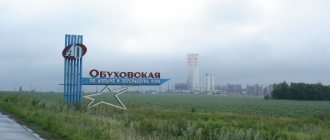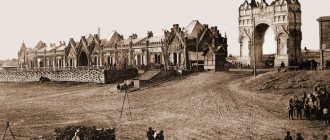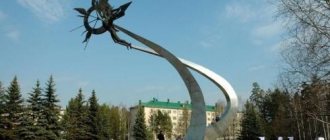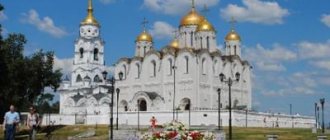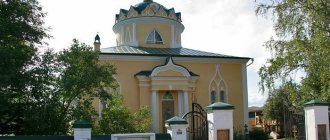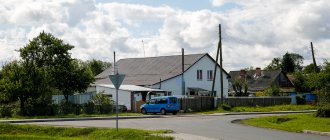Not to be confused with Uzhur-4.
City in Krasnoyarsk Krai, Russia
| Uzhur Uzhur | |
| City [1] | |
| Flag Coat of arms | |
| Location of Uzhur | |
| Uzhur Location of Uzhur Show map of Russia Uzhur Uzhur (Krasnoyarsk region) Show map of Krasnoyarsk Territory | |
| Coordinates: 55°19′03″N 89°49′21″E / 55.31750°N W. 89.82250°E / 55.31750; 89.82250 Coordinates: 55°19′03″N 89°49′21″E / 55.31750°N 89.82250°E / 55.31750; 89.82250 | |
| A country | Russia |
| Federal subject | Krasnoyarsk region [1] |
| Administrative region | Uzhursky district [1] |
| District city | Uzhur [1] |
| Based | 1760 |
| City status from | 1953 |
| Height | 380 m (1250 ft) |
| population size (2010 Census) [2] | |
| • General | 16 093 |
| Administrative status | |
| • Capital from | Uzhur district [1], district town of Uzhur [1] |
| Municipal status | |
| • Municipal district | Uzhur municipal district [3] |
| • Urban village | Urban settlement Uzhur [3] |
| • Capital from | Uzhur municipal district [3], urban settlement Uzhur [3] |
| Timezone | UTC+7 (MSK+4[4]) |
| Postal code [5] | 662250–662255 |
| OKTMO ID | 04656101001 |
| Web site | uzur-admin.ru |
Uzhur
(Russian: Узhur) is a city and administrative center in the Uzhursky District of Krasnoyarsk Krai, Russia, located approximately 300 km (190 mi) from Krasnoyarsk between the Kuznetsk Alatau and Solgon mountain ranges, where the Chernavka River flows into the Uzhurka. Population: 16,093 (2010 census); [2] 17,252 (2002 census); [6] 28,376 (1989 census). [7]
Links[edit]
Church in Uzhur
Notes[edit]
- ^ abcdefgh Law No. 10-4765
- ^ a b Federal State Statistics Service (2011). “All-Russian Population Census 2010. Volume 1" [All-Russian Population Census 2010, vol. 1]. All-Russian Population Census 2010 [All-Russian Population Census 2010]
. Federal State Statistics Service. - ^ abcde Law No. 13-3028
- "On the Calculation of Time". Official Internet portal of legal information
. June 3, 2011. Retrieved January 19, 2022. - Post office. Information and computing center of OASU RPO. ( Post office
).
Search for postal service objects ( postal Search for objects
) (in Russian) - ↑
Federal State Statistics Service of Russia (May 21, 2004).
“The population of Russia, the constituent entities of the Russian Federation as part of federal districts, urban settlements, settlements, settlements of 3 thousand or more people” [Population of Russia, its federal districts, federal districts, districts, urban settlements, rural settlements - administrative centers and rural settlements with a population of more than 3,000 people] (XLS). All-Russian Population Census 2002
. - “All-Union Population Census of 1989. The current population of union and autonomous republics, autonomous regions and districts, territories, negative phenomena, urban settlements and rural district centers” [All-Union Population Census of 1989: current population of union and autonomous republics, Autonomous regions and districts , territories, regions, districts, urban settlements and villages performing the functions of district administrative centers. All-Union Population Census of 1989 [All-Union Population Census of 1989]
.
Institute of Demography of the National Research University: Higher School of Economics [Institute of Demography of the National Research University: Higher School of Economics]. 1989 - via Demoscope Weekly
. - Uzhur city profile
- https://www.janes360.com/images/assets/692/47692/Russia_upgrades_its_missile_arsenal.pdf
Beauty in Uzhur style: life in a provincial town
Heading to the lakes, many Krasnoyarsk residents have to pass through Uzhur. Nonresident guests usually remember the Uzhur pink elephant - a fountain in the city center, which is difficult for Krasnoyarsk residents to perceive as a fountain. However, it is he who is the unspoken symbol that distinguishes the city from others.
But if you take a closer look, you can see many more interesting things. Here, for example, is Lenin, who leads the country to socialism.
But, probably, the reference point for socialists is the church. Many call this one of the main paradoxes of the city.
Last year Uzhur celebrated its 65th anniversary. There are still many reminders of the Soviet past here.
But the city is developing rapidly - the authorities recently received a new bus after the Universiade. True, so far there is only one - almost like a modern Krasnoyarsk trolleybus. And this is what the rest of the transport in the city looks like.
He walks along new roads past fresh flower beds in the city center.
Past the once renovated retail space. This is what the Trade House looks like, for example. Even before the renovation, it was a Department Store where all Uzhurs shopped. Now half of the departments here are empty - rent is expensive and entrepreneurs are simply giving up space.
And under the cladding of the building there is not the most modern architecture.
And if you walk around the building, even more colorful landscapes will open up. It is a few meters from the main street of the city. There is a small river here that gradually turns into a stream.
But the city can boast of fresh asphalt. There was no longer any left for the exits, but the road itself looks quite neat. There are even traffic lights near schools to highlight crossings.
In general, you can count the number of controlled intersections in the city on one hand. But the traffic here is not so busy, so in the evening the traffic lights are usually turned off.
Secondary roads, especially in the private sector, usually look like this.
The road to one of the best establishments in the city, Papa Miho, looks about the same. The cuisine and service here are not inferior to the restaurants of this chain in Krasnoyarsk, but the parking situation is much worse.
But they are working on sidewalks in the city. Paths and passages near schools now look especially neat and safe.
One of the city's sports clubs also looks modern. True, only one, but with bicycle parking.
A lot is really being done for sports in the city - for example, the Lokomotiv stadium, which is considered the main stadium in the city.
True, up close it looks more modest.
But sports grounds in schools look much worse.
In the educational institutions themselves around the city, plastic windows are installed. The desks are probably also being gradually changed. Or is this a new form of education – TVK News was unable to find out.
And after school, the Uzhur children go to play football.
“You take a picture of this, show the housing and communal services - we have already torn 10 balls here,” the schoolboy shouted when he saw the camera on the playground.
In other yards there are better-kept “boxes”.
And somewhere there are none at all and children just go out to kick a ball in a field near the road.
In other courtyards there are not so much platforms, or even water - people here still go to the water pump with buckets.
Both barns and strange balconies can surprise you with the architecture of courtyards.
There are few five-story houses in the city, most of them are located in the military town and in the SMU microdistrict, but in the latter there are only 5 of them. However, living in apartments, the Uzhurs do not give up their “plots”, growing vegetables right on the site of garage rows, next to them or even along houses.
The situation is absolutely normal for the provinces - for example, a vegetable garden near a modern kindergarten.
In general, you can find many amazing things in the architecture of the city.
Or, on the contrary, the usual ones - for example, the story with fences familiar to Krasnoyarsk.
But if demolished buildings can still be hidden with a fence, then it will not be possible to hide abandoned houses - there are too many of them in the city.
One of the main problems of the city is the swamp, which is growing every year. There is no way to drain it, so people simply leave and abandon their houses, and sometimes entire streets. Gradually the water approaches other buildings and history repeats itself.
But they are trying to green the city. Some parts of it look like this.
Here, next to the old trees, they are trying to grow new ones.
True, the city also has a problem with conifers. For example, it is not very clear how mature trees will live with a tire on the trunk.
A successful example of landscaping is the Uzhursky railway station. Previously, a significant part of the townspeople worked at the depot, but now there are fewer and fewer places left, and many are transferred to branches of other cities.
But the station square still looks very neat.
But residents of the park next to the station are not settling in so quickly.
Another picturesque place is the park in the very center of the city. The already familiar fence and the river, which is gradually becoming smaller.
There is a house right next to the park, next to which, behind a high fence, there are cars. As of 2022, this property belongs to the priest of the local Peter and Paul Church. The temple itself is located literally 200 meters from this place.
Another place that was once a local landmark is the fence along the grain elevator. But it hasn't been updated for many years.
Over the years, vandals have not even raised their hands to spoil this beauty. But time has not been kind to the legendary fence.
In general, this is an ordinary provincial town, where young people often return, and where graduates often leave forever.
Let us remind you that recently the government has become more actively interested in the territories. For example, Yeniseisk should be “born again” for the anniversary, and in the south the edges of the territory will unite around Minusinsk. True, the government does not give an exact time frame for when it will be possible to evaluate the result.
Story
The name comes from the Buryat “uzur”
- “river mouth”[3]. Previously - the village of Uzhur. Uzhur was the center of the Uzhur volost of the Achinsk district.
Founded in 1760, until 1822 it was a small village (ulus) inhabited by Khakassians. Since 1822 - the center of the Uzhur volost of the Achinsk district of the Yenisei province. A stone church was built here in 1857. In 1890 a telephone exchange appeared. In 1911, the village consisted of 326 households. In 1914, construction of the Achinsk-Minusinsk railway began. In 1922, he served in Uzhur and worked on the book “In the Days of Defeats and Victories” by A. Gaidar (Golikov). City status since 1953.
Interesting Facts
Until 1969 (possibly before 1983) there was a children's railway in Uzhur[17].
- opened: August 1951
- closed: no earlier than 1969
- length: 0.6 km
- 2 stations: “Salyut” and “Pobeda”
- rolling stock: electric locomotive ED-1 and 2 wooden passenger cars
- length: 0.6 km
Throughout history, there were only three electrified children's railways in the USSR: the Children's Railway in Gorky Park in Moscow, the Children's Railway in Uzhur and the Children's Railway in Donetsk. None of them have survived.
The action of the film “The End of the Emperor of the Taiga” begins in Uzhur, when the hero of the film, A.P. Gaidar, utters the phrase: ““I arrived in Uzhur - neither “hello”, nor “bonjour”.
Economy
The economic profile of Uzhur is determined by its position in a large agricultural region and on the railway. Uzhur has a vast territory with highly developed grain production, meat and dairy cattle breeding and sheep breeding. Thanks to this, the city became a major center for processing agricultural raw materials. There are about 50 industrial enterprises of all forms of ownership in Uzhur. The monopoly role belongs to the food industry (up to 90% of the cost of production): a dairy plant, a bakery, and a fish factory that processes imported and local fish (peled, bream, whitefish, and omul are bred in the freshwater lakes of the adjacent territory). There are construction industry enterprises.

